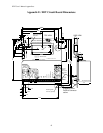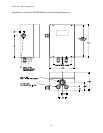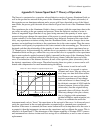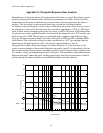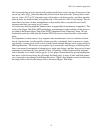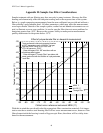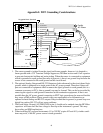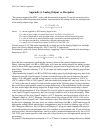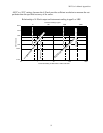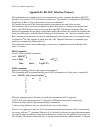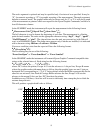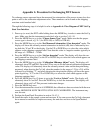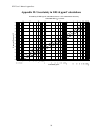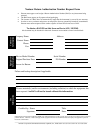XDT User’s Manual Appendices
50
Appendix J: Analog Output vs. Dewpoint
The current output of the XDT, varies with the measured dewpoint. To use the current to calcu-
late the value of the dewpoint measurement, one must know the settings of the low and high ends
of the analog output range, then:
where: I = current supplied by XDT analog output in mA.
Z = value of zero output of current loop in mA: for 4/20 = 4, for 0/24 = 0.
H = value of High end of Analog Output range, converted to selected engineering units
L = value of Low end of Analog Output range, converted to selected engineering units
D = dewpoint measured by instrument in selected engineering units.
S = span in mA of current loop output: for 4/20 = 16, for 0/24 = 24.
Consult section 3.4.5.7&8 and/or appendix B, to check and set the Analog Output low and high
ranges; the factory default settings are -100°C and +20°C respectively.
For example a unit with factory default settings, supplying 12mA is computed to be measuring a
dewpoint of -40°C:
Note that the computation is such that the current is linear to the selected engineering units.
Hence, selecting ppmV or LBS or G/M3 units, will cause the analog output to be linearly propor-
tional to those units (approximately logarithmically proportional to dewpoint), refer to the graph
that follows. Naturally selecting °C or °F will cause the analog output to be linearly proportional
to dewpoint.
When monitoring in ppmV or LBS or G/M3, the analog output low & high ranges may have to be
adjusted to provide a useful output. Consider an example where the area of interest to be moni-
tored is 10 to 100 ppmV, and the analog output is set up with the factory defaults of -100°C to
+20°C (which is 0.014 to 23612 ppmV); then the current loop output will vary only from ~4.1 to
~4.2 mA in the area of interest (consult with the graph on the following page). In most instances
this would be an unacceptable output for proper monitoring of the measurement. In this example
the user should adjust the analog output low & high ranges such that the output range is better
suited to the measurement of 10 to 100 ppmV. It may be useful to select the low and high ranges
to be 5 and 150 ppmV respectively, thus out of range conditions will be detected properly. Then
the low range will be set to 5ppmV which is -65.5°C dewpoint, and the high range will be set to
150ppmV which is -38.5°C dewpoint. Now the current loop output will be 4.55 to 14.48 mA in
the range of 10 to 100 ppmV, the ~10mA variation is more than sufficient for a good measurement
by the user’s equipment. One may carry out similar calculations for LBS or G/M3 and choose the
appropriate settings.While making these computations it may be useful to obtain a copy of Xen-
taur’s dewpoint calculator, this is a Microsoft Windows™ program which simplifies the process
of converting dewpoint measurement units. It is available at www.xentaur.com. If you are not cer-
tain how to carry out such calculations, send by e-mail to xentaur@xentaur.com or by fax to (631)
345-5349, your system specifics, and some one will get back to you with appropriate analog out-
put settings.
In general, if the dewpoint is monitored in °C or °F, there is no need to change the factory default
D
IZ–()HL–()×
S
-----------------------------------------
L+=
12 4–()20 100–()–()×
16
------------------------------------------------------------
100–()+40–=



